
"I guess I am thinking a lot about the early 2000s lately, like a lot of people, I think, in their 30s."
That’s one of the first things writer, game designer, and podcaster Merritt K said to me in early November. At this moment, everything about gaming, and being online generally, was fundamentally easier than it was at the turn of the century. You can now play intensive triple-A games on a cheap phone, given a cloud gaming subscription and a decent wireless connection. You can set up a chat room, build an online presence, even publish videos, instantaneously, for free. Performance-minded and customizable PC gaming hardware is just a few clicks and a couple days away from showing up at your door.
And yet we're both hopelessly wistful for something else entirely: LAN parties. Merritt K so much so that she's writing, compiling, and crowdfunding a book: LAN Party. It's a collection of original amateur photos—many upscaled through AI—and short essays on a period when multiplayer gaming meant desktop towers, energy drinks, and being physically present in some awkward spaces. It's been in the works for more than a year, but she's been thinking about it much longer.
"Some reasons for that are just nostalgia, like, 'Remember when you were a teen, listening to emo music, going to LAN parties and stuff.' But there is another aspect of it, where the Internet that I think a lot of like, Gen X, elder millennial, or mid-millennial-aged people grew up with, is basically falling apart," Merritt K said. "We've felt like this thing that was so important to me, Internet culture and being online and tech and all this stuff—it was so hard to be growing up, and it gave me a way to talk to people and make connections.
"And now it's like the opposite of that. Real life is where you can have meaningful interactions with people, and online is where you have to present this brand, this manicured identity. I think one thing that appeals to people, and to me, about LAN parties is they're kind of emblematic of this earlier era of tech, when things were a little rougher around the edges."

From late-night tweet to AI upscaling
The decline of truly DIY consumer tech, the 20-year nostalgia window, the isolation of COVID-19—some or all of these guided a late-night tweet of Merritt K's in September 2021 to nearly 100,000 likes. Over four harshly lit images of people wearing patently millennium-era clothing: "I want to produce a coffee table book that's just pictures of LAN parties from the 90s and 2000s." Two minutes later: "Do not steal this idea it's mine someone please publish this."
I want to produce a coffee table book that’s just pictures of LAN parties from the 90s and 2000s pic.twitter.com/2YpOn8U5cF
— merritt k (@merrittk) September 2, 2021
Someone is indeed publishing this: the UK-based videogame history publisher Read-Only Memory. Merritt K sought out original photos and heard from hundreds of eager fans. Some had to dig through old media and hope entropy had yet to set in. Some still had image folders sitting on long-neglected but public web servers. Merritt K had seen many of the famous LAN party memes—the San Antonio Spurs playing StarCraft on a plane next to their NBA championship trophy, the guy duct-taped to a ceiling—but was taken aback by how rich the lesser-known photos she received were.
"The composition in some of these is, accidentally, so good," Merritt K said. "They just reveal so much about the era in terms of the fashions, the food, the drinks, even the interior decor. I think that resonated with a lot of other people, too."
The people who frequented LAN parties tended to be early adopters, and that included digital photography—grainy, yellow-timestamped, single-digit-megapixel, point-and-shoot digital photography. Untrained photographers shooting with Y2K-era gear in dimly lit spaces lent the photos Merritt K collected a lot of charm but also made many of them impossible to publish in high-resolution print.

Enter Gigapixel AI, learning software that can upscale images up to 600 percent. Gigapixel upscaled famous 1896 films of trains arriving, helped another AI claim a controversial art fair win, and further blurred the line between digital photo and illustration. Some interesting photos had to be left out because they were just too dark or blurry, even with AI help. Others made Merritt K and her editors question the line between the dark-basement reality and needing images that worked in a physical book. It was a tricky balance, Merritt K said, but the overall spirit was enlightenment and entertainment, not light-balance accuracy.

reader comments
222